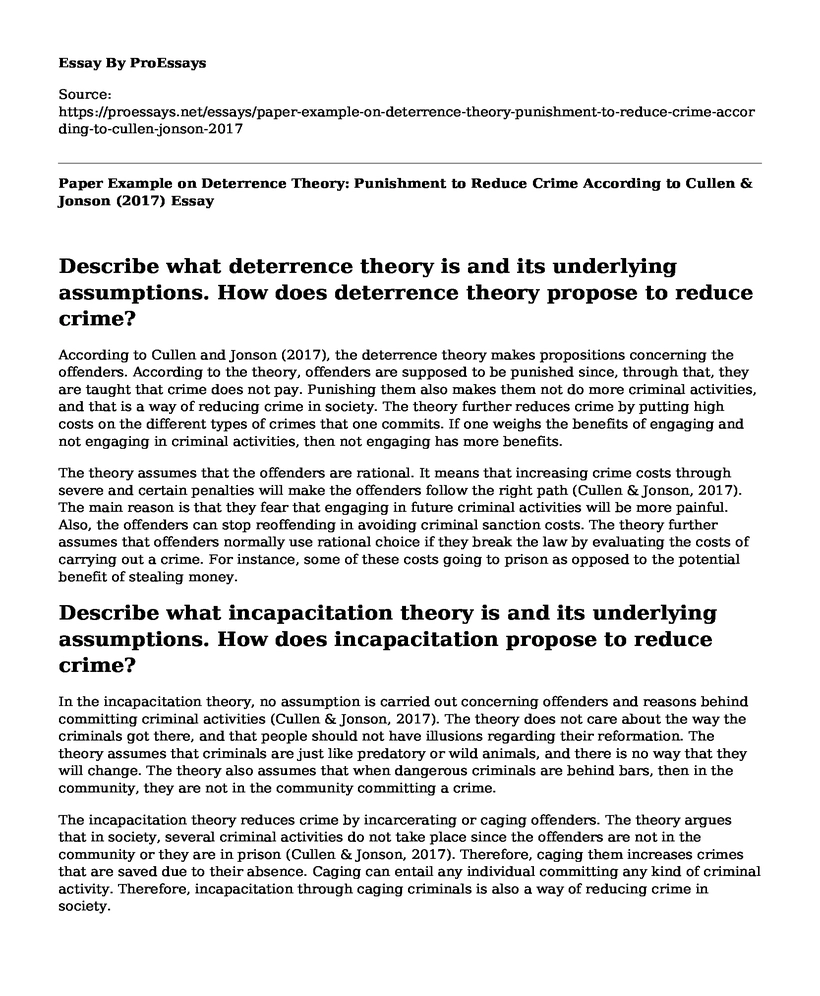Describe what deterrence theory is and its underlying assumptions. How does deterrence theory propose to reduce crime?
According to Cullen and Jonson (2017), the deterrence theory makes propositions concerning the offenders. According to the theory, offenders are supposed to be punished since, through that, they are taught that crime does not pay. Punishing them also makes them not do more criminal activities, and that is a way of reducing crime in society. The theory further reduces crime by putting high costs on the different types of crimes that one commits. If one weighs the benefits of engaging and not engaging in criminal activities, then not engaging has more benefits.
The theory assumes that the offenders are rational. It means that increasing crime costs through severe and certain penalties will make the offenders follow the right path (Cullen & Jonson, 2017). The main reason is that they fear that engaging in future criminal activities will be more painful. Also, the offenders can stop reoffending in avoiding criminal sanction costs. The theory further assumes that offenders normally use rational choice if they break the law by evaluating the costs of carrying out a crime. For instance, some of these costs going to prison as opposed to the potential benefit of stealing money.
Describe what incapacitation theory is and its underlying assumptions. How does incapacitation propose to reduce crime?
In the incapacitation theory, no assumption is carried out concerning offenders and reasons behind committing criminal activities (Cullen & Jonson, 2017). The theory does not care about the way the criminals got there, and that people should not have illusions regarding their reformation. The theory assumes that criminals are just like predatory or wild animals, and there is no way that they will change. The theory also assumes that when dangerous criminals are behind bars, then in the community, they are not in the community committing a crime.
The incapacitation theory reduces crime by incarcerating or caging offenders. The theory argues that in society, several criminal activities do not take place since the offenders are not in the community or they are in prison (Cullen & Jonson, 2017). Therefore, caging them increases crimes that are saved due to their absence. Caging can entail any individual committing any kind of criminal activity. Therefore, incapacitation through caging criminals is also a way of reducing crime in society.
Please compare and contrast restorative justice and rehabilitation. What similarities do you see between the two theories? How do these two perspectives differ?
According to Cullen & Jonson (2017), restorative justice aims to ensure that all the existing harm is efficiently rectified, and there is the restoration of injured parties, while rehabilitation aims at intervening in changing the factors making offenders break law. Restorative justice and rehabilitation are both utilitarian (Cullen & Jonson, 2017). Restorative justice argues that its harm reduction approach has a high chance of lowering recidivism as compared to the normal correctional response, and rehabilitation utilitarian assumes that different factors determine crime, including dysfunctional family, bad opinions, and antisocial attitudes. Besides utilitarian, restorative justice is non-utilitarian as it has an overriding concern regarding getting justice.
Rehabilitation assumes that if offenders are incapacitated without any treatments, then the person is left worse off, while restorative justice assumes that offenders should be accepted back in society. The offenders should also restore the community, which they harmed (Cullen & Jonson, 2017). Although these two theories are different, both of them advocate for the well being of the offenders. They believe that offenders can also change.
References
Cullen, F. T., & Jonson, C. L. (2017). Correctional Theory: Context and consequences. Sage Publications.
Cite this page
Paper Example on Deterrence Theory: Punishment to Reduce Crime According to Cullen & Jonson (2017). (2023, Jul 24). Retrieved from https://proessays.net/essays/paper-example-on-deterrence-theory-punishment-to-reduce-crime-according-to-cullen-jonson-2017
If you are the original author of this essay and no longer wish to have it published on the ProEssays website, please click below to request its removal:
- Research Paper on Ted Bundy
- Essay Sample on Boeing Credit Card Fraud
- Essay Sample on Emerging Problems in Criminal Justice System: High Rates of Drug Use, Juvenile Offenders, & Violence
- Research Paper on Criminology: Extent, Consequences, Causes, Prevention & Control
- Essay Sample on Barak Obama's ACA: Wider Access to Healthcare or Controversy?
- Ex-Convicts Reentering Society: Challenges & Solutions - Essay Sample
- Paper Sample on Capstone Corp Dismissal: Paula's Right to Free Speech







